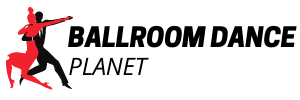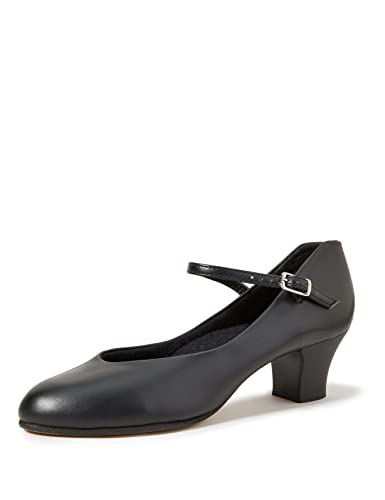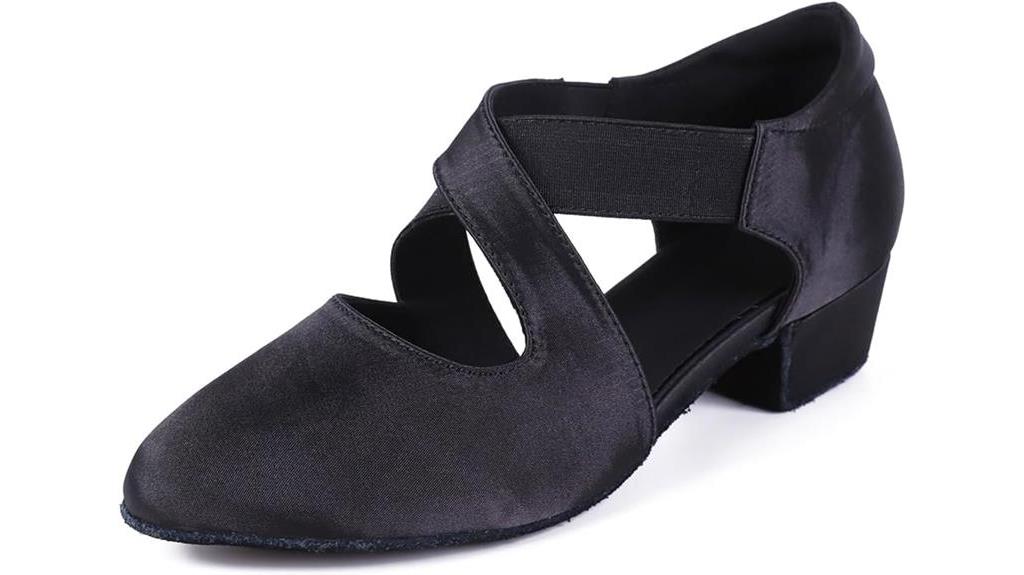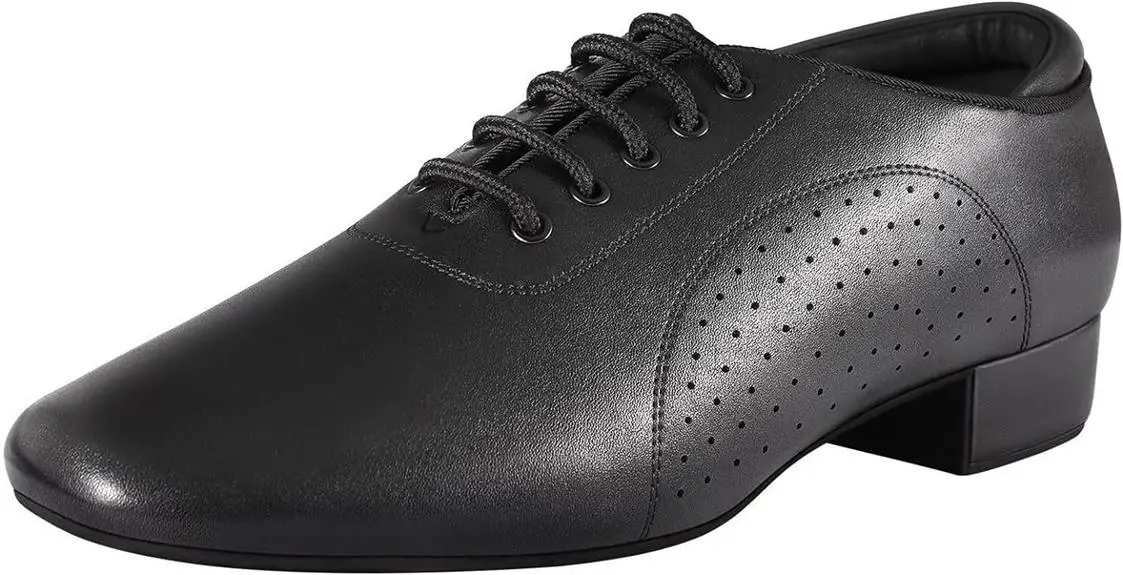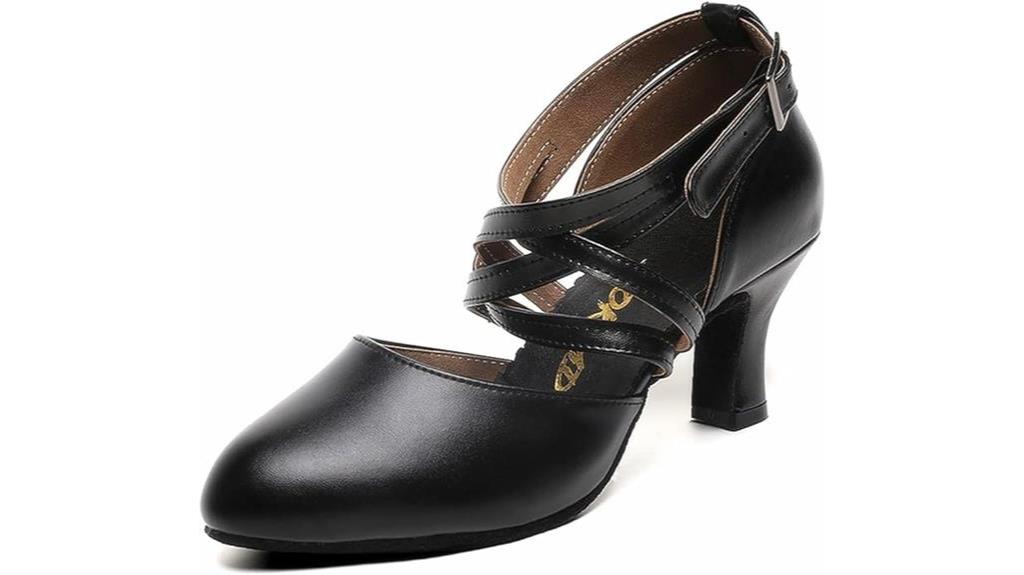Whether you’re a beginner or an experienced ballroom dancer, having the right practice shoes is important. In this blog post, we’ll share 9 of the best ballroom dance practice shoes on the market.
We’ll also provide tips on choosing the right pair of shoes for your needs. So, read on, whether you’re in the market for new dance shoes or just curious about what’s out there!
At a Glance: Our Top Ballroom Practice Shoes
Ballroom Practice Shoe List
1. Gabriella by VeryFine
Looking for a high-quality practice shoe that will help you dance the night away? Look no further than Gabriella by VeryFine.
These beautiful and comfortable shoes are made with premium synthetics that stretch to fit your feet, avoiding those nasty blisters from other shoes that fit a little loose.
They also feature a cushioned heel to protect your feet from wear and tear and arch support for increased stability.
So whether you’re hitting the dance floor or the practice room, Gabriella by VeryFine has you covered.
2. Capezio 550
The Capezio 550 practice shoe is a great choice for anyone starting out in dance.
The 100% synthetic leather sole and soft PU leather upper provide exceptional comfort and support, while the moisture-absorbent microfiber lining helps keep feet dry during long practice sessions.
The leather buckle, Achilles notch, and lightly padded collar provide additional support and comfort, and the 1.5″ plastic heel with scored leather top lift ensures stability and durability.
These shoes are also available in a wide variety of sizes to accommodate both children and adults.
So, whether you’re just starting out or have been taking classes for years, the Capezio 550 practice shoe is a great option.
3. VeryFine CD702BBX
Professional dancers need shoes that can stand up to hours of practice and performance, and the CD702BBX from VeryFine Dancesport is a great option.
This shoe features a split suede sole, allowing easy spinning and turning, making it ideal for practice on the wood floor.
The lace-up design ensures a snug and comfortable fit, while the 1.5″ heel provides just the right elevation.
In addition, the cushioned insole and footbed offer shock absorption for added comfort.
These shoes feature extra-thick memory padding to absorb shock and provide strong resistance against high pressure and pad deformation.
They also have a soft leather inside lining for added comfort. The genuine lambskin leather and breathable mesh upper provide breathability and comfort.
Whether you’re a beginner or a seasoned pro, this shoe is a great choice for any dancer.
4. Bloch Dance Shoes
Bloch practice shoes are a great choice for dancers looking for a split, non-marking outsole sneaker made on a high arch with lightweight, high-performance materials.
These shoes come with built-in arch support and elevation to accentuate the arch, and they also have a pivot point that allows for 360-degree movement.
The four-part high-density P.U. outsole is durable and designed for maximum flexibility, while the spin spot allows 360-degree turns.
The sizing for practice shoes differs from street shoes; women should order one full size up, and men should order two full sizes up.
Those with wide feet may need to order 1 1/2 sizes up.
In addition, the practice shoes have a DRT cushioned heel for maximum shock absorption and comfort.

5. VeryFine 1670C
If you are looking for a versatile practice shoe that can be used for various dances, the VeryFine 1670C is an excellent option.
The quick-release buckling system makes putting on and taking off easy, and the suede sole is ideal for practicing on a wood floor.
The extra cushioned insole and footbed help to absorb shock and add comfort; the heel measures approximately 1.5″.
The synthetic upper is also very flexible and lightweight, making it comfortable to wear for extended periods.
Whether you are a beginner or a professional dancer, the
VeryFine 1670C practice shoe is a great choice.
6. YYTing Shoes
If you’re looking for a quality practice shoe that won’t break the bank, YYTing is a great option.
The satin upper is soft and comfortable, and the suede sole provides good traction.
The shoes are also 1.5” heels, enough to protect your feet while dancing but not so high that you’ll have difficulty walking or standing in them.
The elastic band makes them easy to put on and take off, and the low-key luxury design is perfect for practice or performance.
YYTing dance shoes are the perfect practice shoes for Latin, Salsa, Tango, Rumba, and ChaCha dancing.
They are lightweight and flexible, allowing you to feel the freedom and comfort of movement while you practice your incredible dance moves.
The shoes are also great for performing, as they help you execute each step precisely.
Additionally, the shoes are versatile enough to be worn on many occasions.
You can wear them indoors for leisure dancing or practice, or you can even wear them to a competition or wedding.
Choose the right shoe according to our size chart, and don’t worry if they feel a little tight at first – they will stretch to fit your feet perfectly in no time.
Ballroom Practice Shoe Chart
| Brand | Sole | Material | Heel | Reviews |
|---|---|---|---|---|
| Gabriella by VeryFine | Suede | premium synthetics | 2.5″ | See all Reviews |
| Capezio 550 | Leather | 100% Synthetic | 1.5″ | See all Reviews |
| VeryFine CD702BBX | Suede | Leather | 1.5″ | N/A |
| Bloch | Rubber | 100% Leather and Textile | 1 1/4″ | See all Reviews |
| VeryFine 1670C | Suede | Synthetic Upper | 1.5″ | N/A |
| YYTing | Suede | Satin upper | 1.5″ | See all Reviews |
Ballroom Dance Practice Shoes Guide
Style of Dance:
- Different ballroom dances have distinct movement patterns and footwork requirements. Before buying dance shoes, identify the specific style of dance you’ll be focusing on, whether it’s Waltz, Tango, Foxtrot, Cha-Cha, or others. Each dance may have unique demands on the shoes in terms of flexibility, support, and heel height.
Material and Construction:
- Opt for shoes made from high-quality materials, typically leather or suede for the sole. Leather is durable, provides flexibility, and molds to the shape of your feet over time. Suede soles offer the right amount of traction on dance floors. The upper part of the shoe should be breathable and comfortable, allowing for ease of movement.
Comfort and Fit:
- Comfort is paramount in dance shoes. Ill-fitting shoes can not only lead to discomfort but also hinder your progress. Ensure the shoes provide adequate arch support, cushioning, and a snug fit without being too tight. Most dance shoes are available in specialized widths, so choose accordingly to accommodate the shape of your feet.
Heel Height:
- Heel height is a crucial consideration, especially for beginners. Higher heels may add elegance but can be challenging to manage for those new to ballroom dancing. Start with a lower heel, typically between 1 to 2 inches, until you gain more experience and confidence. A stable and well-balanced heel is essential to prevent injuries and maintain proper posture.
Sole Type:
- Ballroom dance shoes come with different sole options – split sole or full sole. Split soles provide enhanced flexibility and articulation of the foot, allowing for better pointing and extension. Full soles, on the other hand, offer more stability and support. The choice between the two depends on personal preference and the style of dance you’re learning.
Ankle Straps and Closure:
- Ankle straps add an extra layer of support, preventing the shoes from slipping off during intricate footwork. Consider whether you prefer open or closed-toe designs and whether you want a traditional buckle closure or a quick-release option like a hook-and-loop strap. The choice depends on personal comfort and the level of security you desire.
Weight of the Shoes:
- Lightweight shoes are generally preferred for ballroom dancing as they allow for quick and precise foot movements. Heavy shoes can impede agility and make it challenging to execute certain dance steps. Look for shoes that strike a balance between durability and weight, ensuring they are both sturdy and easy to move in.
Budget Considerations:
- While quality dance shoes are an investment, they don’t have to break the bank. Set a reasonable budget based on your commitment to ballroom dancing. Reputable brands are offering affordable options without compromising on quality. Keep in mind that well-made shoes can contribute significantly to your dance experience and progression.
“We wouldn’t recommend spending more than about $60 on your first pair of dance shoes. We’ve bought really expensive shoes before, and some were the pairs we disliked the most after wearing them and breaking them in… Plus, you’ll be disappointed when they get ruined out at the clubs!”
https://demuredance.com/blog-posts/2018/12/27/shoes-shoes-shoes
Brand Reputation:
- Research and choose reputable brands known for their dedication to dance footwear. Read reviews, seek recommendations from instructors or fellow dancers, and consider the experiences of others when making your decision. Established brands often have a history of producing reliable, comfortable, and durable dance shoes.
Testing the Shoes:
- Whenever possible, try on multiple pairs before making a final decision. Walk around, practice some basic dance steps, and assess how the shoes feel on your feet. Pay attention to any discomfort, pressure points, or instability. If purchasing online, ensure the retailer has a flexible return policy to allow for exchanges or returns if the shoes don’t meet your expectations.
(FAQ)
What to look for in ballroom dance practice shoes?
When looking for ballroom dance practice shoes, you’ll want to find a comfortable pair that provides good traction.
Comfort is key; you’ll likely wear your practice shoes for extended periods.
Make sure the shoes have a soft interior and are well-cushioned.
Additionally, look for a sleek design to help you move easily across the dance floor.
Traction is also important, as you’ll need to be able to move quickly and gracefully without slipping.
Look for shoes with a rubber sole that provides a good grip on all surfaces.
How do you choose the right pair of ballroom dance practice shoes?
When choosing ballroom dance practice shoes, there are several things to remember.
First, you’ll want to ensure the shoes are comfortable and provide good support.
Second, you’ll want to choose shoes with smooth soles to glide across the floor easily.
Third, you’ll want to pick a shoe that is the right size.
Ballroom dance shoes tend to run small, so it’s important to try them on before you buy them.
What shoes do you need to learn ballroom dance?
Consider the following guidelines:
1. Ballroom Dance Shoes: Opt for specialized ballroom dance shoes. They have suede or leather soles that provide a balance of grip and slip, making it easier to pivot and glide on the dance floor.
2. Low Heels: Choose shoes with low, wide heels, typically 1-2 inches high, to ensure stability and balance while learning the basics.
3. Comfortable Fit: Select shoes that fit well, offering support and preventing blisters during practice.
4. Closed-Toe Design: Closed-toe ballroom shoes are a good choice for beginners, providing extra support and elegance.
These shoes are designed to enhance your dance experience and facilitate learning the fundamental steps and movements of ballroom dance.
Do you wear socks with practice dance shoes?
In most cases, it’s not necessary to wear socks with practice dance shoes.
Practice dance shoes, especially those designed for ballroom or Latin dance, are typically crafted to be worn without socks.
The suede or leather soles provide the right balance of grip and slip on the dance floor, ensuring you can feel and control your movements.
However, some dancers may prefer to wear very thin, low-profile dance socks or foot thongs for hygiene or comfort reasons, but this is a personal choice.
It’s essential that whatever you choose to wear inside your dance shoes doesn’t interfere with your ability to move, balance, and pivot smoothly.
What should I wear to my first ballroom dance class?
For your first ballroom dance class, wear comfortable yet practical attire to ensure a great learning experience:
1. Clothing: Choose lightweight and breathable clothing that allows freedom of movement. Leggings or dance pants for women and slacks for men are ideal. A comfortable top, like a T-shirt or a blouse, is appropriate.
2. Shoes: Opt for low-heeled ballroom dance shoes if you have them, or comfortable closed-toe shoes with smooth, non-grippy soles that won’t mark the floor.
3. Hair and Accessories: Tie long hair back to keep it out of your face. Avoid wearing excessive jewelry that could interfere with your partner or movements.
4. Hygiene: Ensure you’re well-groomed, as you’ll be in close contact with others.
Remember, the most important thing is to feel comfortable and confident in what you’re wearing, as it can positively impact your dancing experience.
What is the difference between ballroom dance shoes and character shoes?
Ballroom dance shoes and character shoes serve distinct purposes in the world of dance:
Ballroom Dance Shoes:
1. Sole: Ballroom shoes have suede or leather soles designed for smooth gliding and pivoting on dance floors.
2. Heel: They typically feature lower, wider heels to support balance and control during partner dances.
3. Design: Ballroom shoes come in closed-toe or strappy styles, depending on the dance style.
4. Purpose: These shoes are tailored for ballroom and Latin dances, focusing on elegance, footwork, and partner connection.
Character Shoes:
1. Sole: Character shoes have hard leather soles, designed for durability and support for theatrical performances.
2. Heel: They feature higher, slimmer heels, often around 2-3 inches, creating a dramatic stage presence.
3. Design: Character shoes come in both open and closed-toe styles and often feature buckles or straps.
4. Purpose: They are intended for theater, musicals, and character-based dances that require a more theatrical or character look.
In summary, ballroom dance shoes are specialized for ballroom and Latin dancing, while character shoes are designed for theatrical performances, including musicals and character-based dances.
